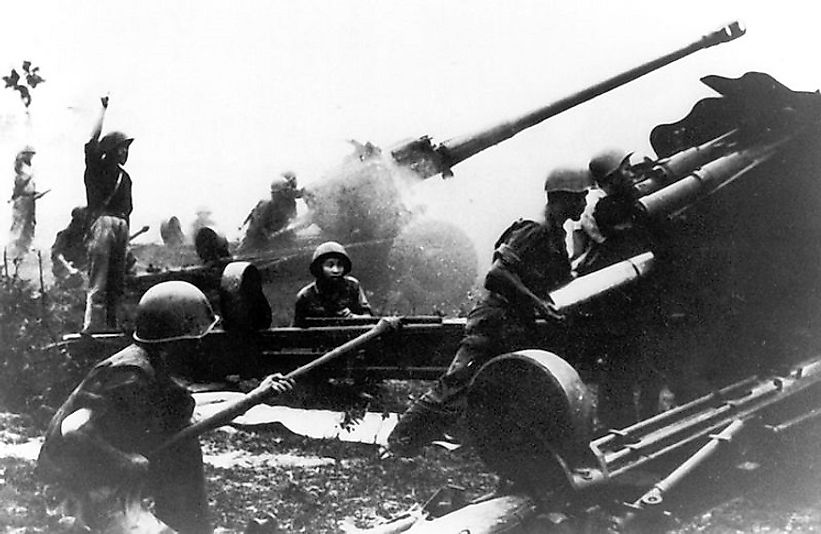The Easter Offensive - Vietnam War

5. Background
With American public opinion becoming increasingly strong against the war and the South Vietnamese showing signs of desperation, the North Vietnamese were increasingly anxious to deal a stunning blow to their enemies in 1972. Even though the U.S. had been expecting an offensive from the North Vietnamese during this period, it was a gross underestimation of the forces they would attack with. Simultaneously approaching three separate fronts at Quảng Trị, Hu and Lộc over the space of 2 months ensured that the defending South Vietnamese army would have to cope with spreading their forces across the various fronts.
4. Makeup
The campaign was contested between the Communist North's People's Army of Vietnam (PAVN) on one side, and the Army of the Republic of Vietnam (ARVN, the regular army of South Vietnam) and United States Navy and Air Force support on the other. The South Vietnamese forces totaled around 760,000 strong, and were led by Generals Hoàng Xuân Lãm, Ngô Quang Trưởng, Ngô Du, Nguyễn Văn Toàn, and Nguyễn Văn Minh. A combined Viet Cong and People’s Army of North Vietnamese force of around a quarter of million troops opposed them, supported by hundreds of tanks and armored personnel carriers, with many of these vehicles being sourced from Chinese manufacturers. The communists were led into battle by North Vietnamese Generals Trần Văn Trà and Văn Tiến Dũng.
3. Description
At Quảng Trị the North Vietnamese advanced at Noon on the 30th of March, 1972, following a heavy artillery barrage on South Vietnamese outposts over 30,000 infantry troops, supported by an additional 100 tanks moved across the five northernmost provinces of South Vietnam. The failure of intelligence preceding the attack as well as the timing of the attack lining up with the annual monsoon season created excellent cloud cover from US airstrikes resulting in outposts greatly outnumbered and available to be captured by the North Vietnamese.
While the Quảng Trị outposts were under heavy attack the South Vietnamese were proving their ability to avidly defend the remaining bases in the area. At this point the North Vietnamese lead by Tran Van Quang made the push toward Hu hoping to and detracting major military attention from the defending armies in Quảng Trị. During this segment of the battle the North Vietnamese managed to capture Firebase Bastogne and attempted a further push southward however the increased fortification of Highway 1 and across the Thach Han to Hu proved too great an obstacle.
At Lộc, the defending South Vietnamese was proved a much more difficult area to maintain as the North Vietnamese were forced to hold attacks in order to resupply from their Cambodian base area which provided an unstable footing for the North Vietnamese. Aerial superiority was maintained by the South Vietnamese, supported by the U.S. Air Force.
2. Outcome
Although the South Vietnamese were able to hold off much of the North’s aggressive assaults, the Communists gained large territories nonetheless in the campaign. While the campaign’s battles lasted a mere 7 months, which in relation to the entire conflict lasting 20 years was a mere speck in the timeline, the casualty rates experienced on both fronts were phenomenal, totaling around an estimated 300,000 military deaths. Exact death tolls are hard to pinpoint, as the North Vietnamese, South Vietnamese, and U.S. records each give very different numbers.
1. Significance
The aftermath of the conflict held bittersweet victories and losses for both sides in the conflict. Where the North Vietnamese had permanently gained the four northernmost provinces in South Vietnam (Quảng Trị, Thừa Thiên, Quảng Nam, and Quảng Tín), the South Vietnamese military still maintained control of their state by thwarting the invading force. This greatly attributed to the underestimation of the North Vietnamese of the defensive capability of the South Vietnamese in the light of US military support and destructive capability of the US air force. Due to the major losses experienced on both sides of the conflict, negotiations were possible as both sides were willing to make compromises based on the transpired events, leading to the total withdrawal of U.S. troops from the state and continued occupancy of North Vietnamese troops in their captured areas.











